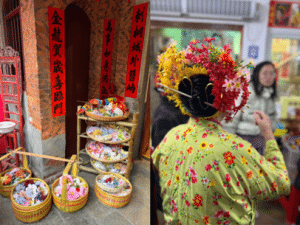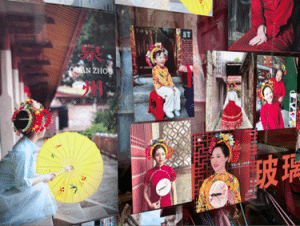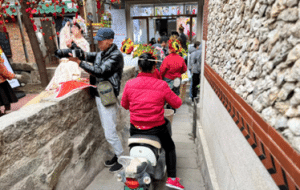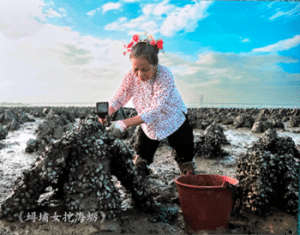A Blessed Origin
As you pass through the bustling crowds, traverse the winding paths of sand and gravel, you arrive at a place where time seems to slow down, and the air is filled with the tranquil scent of burning incense. This sensory symphony is created by mingling of fragrance with the cool, salty ocean breeze. Here lies a small village by the sea, Xunpu Village, located in Quanzhou, a city in southern China. Unlike any other village, Xunpu Village is the successor of an eternal beauty that thrives upon the ingenuity and resilience of its women.

“Zanhuawei” (簪花围) is a unique hairstyle that belongs to the women in Xunpu Village. In Chinese, “Zanhuawei” means garland hairpins. The process of making a “Zanhuawei” begins with braiding one’s hair into a bun shaped like a conch. An ivory pin is then inserted through the bun, and the hair is adorned with flowers in various hues. The hairstyle, resembling the feathers of a peacock, derives its name from“Wei,” which means “circle” in Chinese. The flowers used in “Zanhuawei” have diverse origins, with some growing from Xunpu’s soil while others being imported through maritime trading. These animated garden for the women of the village. For every Xunpu girl, flowers accompany her journey through life. According to ancient folk custom, flowers are a blessing for health and prosperity. Therefore, whenever a Xunpu girl reaches a turning point in her life, from adulthood to marriage, “Zanhuawei” serves as a symbol of elegance and grace for her.
Every year, on the twenty-ninth day of the first lunar month, the villagers gather in a grand procession to celebrate “Mazu’s pilgrimage day.” In ancient Chinese mythology, “Mazu” is the goddess of the sea, protector of sailors and fishers. The pious people of Xunpu pray for the goddess’s blessing by carrying her statue in a red sedan, with thousands following behind. The scene is accentuated by dozens of Xunpu women, adorned with the brightest flowers in their hair, leading the procession with passionate smiles as they strike waist drums.

Embracing Serendipity
As the 1990s approached, modern fashion trends began to sweep through Xunpu Village, with the younger generation opting for novel hair-dye colors over traditional floral adornments. The ephemeral beauty of the floral hairstyles was fading. To preserve this unique fashion, the government recognized “Zanhuawei” as China’s national intangible cultural heritage in 2008, promoting it as an indigenous fashion icon. However, it wasn’t until early 2023 that “Zanhuawei” truly gained eminence. Chinese actress Zhaoliying’s fashion spread featuring the traditional headgear of Xunpu women went viral, sparking a surge of interest in the hairstyle. This unexpected event catapulted Xunpu into the public eye, with an influx of visitors and a proliferation of hair styling shops, from just a few to over 150, lining the village streets like blossoming flowers after a spring rain.
Since the Chinese New Year of 2023, this small village spanning 3.8 square kilometers has become a captivating destination for travelers, attracting thousands of female visitors eager to try the remarkable hairstyle. During peak periods like “International Labor Day” and National Day celebrations, Xunpu welcomes over 20,000 and 50,000 visitors per day, respectively, marking a 30% growth in household income.
This transformation has breathed new life into Xunpu. Elderly artisans, custodians of the ancient art of “Zanhuawei,” now craft exquisite bouquets with meticulous precision. The younger generation, once dispersed, has returned, blending their heritage with modern approaches. Together, they continue to promote and preserve the extraordinary beauty of their ancestral tradition.
A visit to a “Zanhuawei” hairdressing shop reveals a scene of vibrant flowers cascading from countless baskets, filling the air with their intoxicating fragrance. Amidst the lively chatter, artisans put the finishing touches on intricate hairstyles, creating a captivating sight.
Don’t miss the opportunity to capture a moment next to the oyster-shell houses, symbols of the village’s architectural wisdom. Adorned with oyster shells that mimic fish scales, these houses have stood the test of time, offering shelter and comfort through the seasons. They stand as silent witnesses to the village’s rich history, whispering tales of the sea to new visitors and future generations.

An Unwavering Legacy
Though the vibrant hues of flowers may fade with time, the ethereal beauty that resides within the hearts of Xunpu women remains steadfast against the relentless march of time. The dazzling blossoms of “Zanhuawei” have woven tales of joy and serenity, but it is the unwavering dedication of these women that truly elevates it to a revered emblem of beauty.
“In our old days, girls weren’t allowed to cut their hair because it was a natural gift from parents,” said Aunt Bailan, a seventy-two-year-old owner of one of the most popular “Zanhuawei” shops. “As the hair grew longer, we would braid it into a bun so that it is more convenient for us to do labor. Over time, we found a way of making busy work time more cheerful: adorning our hair with garlands.” The essence of “Zanhuawei” originates from the unyielding power and positivity of women. Since the founding of Xunpu village, its female inhabitants have valiantly shouldered the weighty burden of labor and childbirth, fortifying the pillars of family life.
“When I was a little girl, my mother and other women in the village woke up at three o’clock in the morning and went fishing. Then, they would shuck the fresh oysters immediately and carry them to the marketplace on a bamboo shoulder pole. They would wear a simple ‘Zanhuawei’ so that the customers could recognize them easily and knew that the oysters were from Xunpu, and Xunpu has the most delicious oysters around the town,” recalled ZhenZhen Yang, a sixty-six-year-old administrator of the local exhibition hall. “They won’t return until four in the afternoon. But the work wasn’t over. At home, they would start sweeping the floor, washing clothes, and making dinner for the whole family.”
While the women shouldered the dual responsibilities of homemaking and providing sustenance, their tireless efforts often seemed inconsequential to their husbands, the returning voyagers, who assumed a position of superiority, bearing the authority of their maritime exploits.
Xunpu adhered to a rigid system of labor distribution: women worked in the village while men embarked upon the vast sea, seeking trading opportunities. Therefore, traditional norms stipulated women’s responsibilities with a high standard: taking care of children and parents-in-law and engaging in various “supplementary” occupations to augment the family’s income. However, even with such a heavy workload, the phenomenon of “men idling and women working” was only acknowledged when the labor ratio was severely skewed. After four to five months of continuous sailing, men typically spent most of their time drinking, playing Majiang, or wandering, feeling justified in these privileges for having “risked their lives to make money on the sea.”
Despite these challenges, Xunpu women never ceased striving for opportunities to fulfill their potential and demonstrate their initiative. In the 1970s, many women volunteered for sentry duty at seaside watchtowers to protect against armed pirates who threatened to loot villages for wealth. United in purpose, men and women would gather on the beach for training each evening, taking turns patrolling and standing guard throughout the night, ensuring the safety of their community.
“We ate dinner together, and we learned how to shoot together. There’s no difference nor discrimination between men and women,” Zhenzhen Yang said. In the face of danger, the Xunpu women displayed courage, resilience, and unity, transcending societal expectations and proving their worth as capable defenders of their homeland.
As time progressed, the women of Xunpu continued their journey towards emancipation, gradually achieving newfound freedom and the ability to shape their own lives and careers. They shattered the constraints that had once confined them, paving the way for new possibilities and prosperity. With the freedom to choose their paths, they became architects of their own destinies, contributing to the economic development of their beloved homeland. Yet, amidst their remarkable achievements, they remain adorned with a spirit of resilience akin to the graceful blossoms they embody. Most hairdressing shops are operated by women who assume the role of successors to their exclusive legacy. They carry within them a grace in the face of adversity, and their indomitable spirit, nurtured through centuries of arduous dedication, continues to inspire and illuminate the path for future generations.

Fortifying a Path for Change
In his book From the Soil, Xiaotong Fei states, “Land offers the hope of survival for Chinese people, and China’s traditional culture is nurtured by the land.” “Zanhuawei” is an intangible heritage from the land where its creators thrive. With globalization, “Zanhuawei” should embrace diversity and cultural tolerance. Despite Xunpu’s recent progress, new challenges arise as the village aims to create a lasting legacy.
To lay a foundation for sustainable growth, Xunpu needs to shift from “going viral” to “lasting popularity.” This strategy requires detailed planning in business promotion and creative development, as well as improvements in landscape design and infrastructure. Xunpu lacks a comprehensive system of innovative tourism. Although some hairdressing shops sell souvenirs such as “Zanhuawei” fridge magnets, these products need improvement. Villagers hope their hometown can serve as a model for preserving China’s coastal culture, including “Zanhuawei,” its unique celebration of “Mazu’s pilgrimage day,” and tales of the “Maritime Silk Road.”
Once a fishing village, Xunpu’s transformation into a tourist destination faces budget problems. During peak tourism, wire poles block paths, and villagers occupy road space for trading, requiring support and guidance from local officials to promote Xunpu as a tourist destination.
Challenges in Xunpu mirror those in preserving China’s cultural heritage. Though Xunpu women’s efforts raised awareness, preserving their legacy faces challenges due to the struggle between cultural promotion and commercial interest. The tradition of “Qiqiao” in Guangzhou celebrates women’s creativity. To ensure its evolution, the Guangzhou government established the “Qiqiao Cultural Festival,” blending ancient rituals with modern fashion. However, governmental support driven by commercial interests could lead to “homogenization” that dilutes “Qiqiao”’s originality. Commercialization may also put Xunpu’s culture at risk, as tourists may focus on “Zanhuawei”’s external beauty rather than its cultural significance.
To reconcile with commercial thinking, we must appreciate culture as a manifestation of history and uniqueness. Prioritizing the dissemination of cultural heritage can lead to sustainable preservation.



